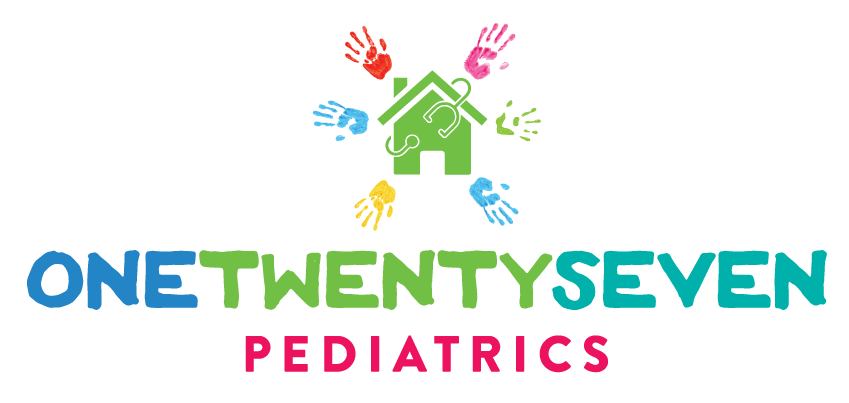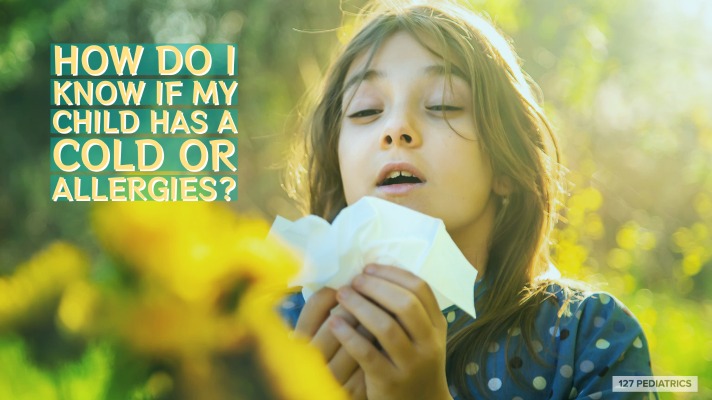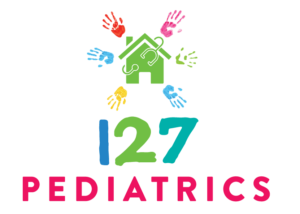Parents often have difficulty distinguishing between cold or allergy symptoms in their children.
As Texans, most of us are familiar with our own allergy symptoms. I tell new families that have recently moved here that everyone is allergic to Texas. It just depends on which season their symptoms will be the worst. Allergy season in Texas occurs in the fall, spring, and winter with different pollen causing problems. We live in one of the worst areas for seasonal allergies in the country.
Seasonal allergies (or allergies to outdoor allergens) are only one type of allergies that children can experience. In our modern world, there are plenty of indoor allergens or environmental allergies as well. From pet dander to dust mites to indoor mold and mildew, there are plenty of allergens that keep us in misery throughout the year.
Common cold symptoms overlap with allergy symptoms, but there are a few things that distinguish these two conditions. In this article, we will look at the distinguishing factors and how you as the parent can tell the difference.
Distinguishing Between Allergies and Colds in Children
There are certain seasons and circumstances in which it seems like a child may have a continuous runny nose for months on end. Sometimes, this is due to back to back viral illnesses. This is especially true in the winter months and more specifically among children who attend child care settings. Germs get passed from kid to kid at daycare or school. When your child is first entering into this setting, they may get several viral illnesses back to back.
We saw this recently as our babies that were born during the pandemic started becoming exposed to kid germs for the first time. Many of these kids had back to back viral illnesses when they started school or daycare. Eventually, a child’s immune system will recognize these viruses and fight them off before you even know that your child was sick.
Additionally, allergies to pollen and other nasal allergies can manifest with runny noses as well. Just like when the body reacts to a germ, it goes into the same reaction mode when it sees an allergen. While runny nose and cough can overlap between both a cold and allergies, there are a few distinguishing symptoms and conditions that can help you to recognize the difference between the two.
Age makes a difference, babies under 2 rarely have allergies
In order for the immune system to react to an allergen, it needs to be exposed multiple times. While I have seen allergies in babies, it is rare for a child under the age of 2 years old to have true seasonal allergy symptoms. Generally, it takes almost two years of repeated exposure to the same allergen before the body reacts.
However, in families with a history of allergies, babies may have symptoms earlier than age 2.
Fever signals an infection, not seasonal allergies
Fever is one of those symptoms that can help you distinguish between a common cold or viral infection and seasonal allergies. While we use names like “cedar fever” to describe symptoms from allergies to the juniper tree in the winter months in Texas, fever with allergies does not usually occur.
Defining fever is important when you are deciding if your child has one or not. Fever is defined as a temperature of 100.4 degrees F or higher. In children who are fully vaccinated, fever is rarely something to worry about. It is simply a symptom of a viral infection and can be accompanied by other cold symptoms such as nasal congestion, sore throat, body aches and GI distress.
Tiredness indicates a viral infection
If your child is sleeping more or increasingly irritable as an accompaniment to their symptoms of runny nose and cough, most likely they have a viral infection. While allergies can wear you down, viral illnesses more often cause fatigue and exhaustion as the body’s immune system is working hard to fight off the invading germs.
Ear infections can result from both allergies and colds. As the inflammation in the upper respiratory tract increases, the fluid in the middle ear is trapped and becomes infected with bacteria. Whether the congestion and inflammation are from allergies or from one of the many respiratory viruses, middle ear infection is common during childhood.
Distinguishing Allergy Symptoms
Any allergy sufferer can tell you what respiratory allergies feel like. Often runny nose or nasal congestion are the main symptoms with the addition of itchy eyes, sore throat and possibly allergic shiners or dark circles under the eyes. Additionally, in kids we often see a line or crease across the front part of the nose that results from a kid rubbing their nose to relieve the symptom of an itchy nose. On physical exams, kids with allergic rhinitis also have boggy or swollen nasal turbinates inside of their nasal passages. It is a common finding that I pick up on often when I am examining a child
Key differences between colds and allergies include these itchy symptoms and stuffy nose vs the fever and fatigue that accompany nasal symptoms in kids with the common cold.
Nasal discharge can be a clue
Common allergy symptoms as well as common cold symptoms overlap when it comes to runny nose and nasal congestion. In general, if these symptoms are due to seasonal or indoor allergies or even pet allergies, the nasal discharge is clear and watery.
Generally, the nasal discharge in kids with viral infections is thick and can either be clear, green, or yellow. Thankfully, thick nasal discharge or even colored nasal discharge rarely indicates a bacterial infection. Mostly, it signals congestion has stayed in the nasal passages long enough for white blood cells to enter the space.
Length of symptoms
Allergy symptoms typically persist for a duration of several weeks or months, depending on the underlying cause.
On the other hand, viral infection symptoms generally last about 7-10 days or even up to two weeks. Sometimes, coughing will continue for a week or two after the resolution of the other symptoms.
Antihistamines help allergy symptoms and not colds
In a kid with a history of allergic rhinitis who ends up with a viral upper respiratory infection, an antihistamine may help alleviate part of their symptoms. However, in general antihistamines only work to relieve symptoms if they are caused by an allergy trigger and not a viral infection.
These medications act to block the histamine that is released in the body in response to the allergen. Blocking histamine keeps the body from reacting to the allergen and helps relieve the accompanying symptoms.
Often, parents will ask me if they can give their kids diphenhydramine (also known as Bendaryl) before bed when they have nasal symptoms. In general, this medication is okay to give, but always talk to your child’s pediatrician first.
As a pediatrician, I mostly recommend the newer or second generation antihistamines. In general, they are safer for kids and non-sedating. These are medications like loratadine and cetirizine (Claritin and Zyrtec).
Treatment of Allergies vs Common Cold
Relief of symptoms is the mainstay of treatment for both allergies and the common cold. While there are more definitive treatments for severe allergies, often treating symptoms will help make your child more comfortable.
Allergy symptoms
In general, allergies are treated with antihistamines and steroid treatments. If your child is also having eye symptoms, you can treat those symptoms with eye drops. For most children with common seasonal allergies, the treatment of choice is a once daily dose of non-sedating antihistamine medication.
These medications are readily available over the counter and you can purchase the formulation that works best for your child. If your child is having predominantly nasal symptoms, your child’s healthcare provider may recommend adding daily nasal spray that contains steroids to calm the tissues in the nose.
If your child experiences severe symptoms or they are difficult to control with standard over the counter medications, a visit to the allergist may be warranted. Usually, an allergist will do more definitive testing such as skin testing that can help determine more accurately what your child is allergic to. After this testing, the allergist may recommend continuing allergy medications or may recommend allergy shots.
A child with allergies may need longer-term treatment with antihistamines. However, most children will only require continuous use of this medication during the season when symptoms are the most bothersome.
Cold symptoms
Unfortunately, even as medical science evolves, there is still no cure for the common cold. The foundation of treatment for cold symptoms is supportive care. This means treating your child’s fever and pain with fever-reducing/pain medicine, suctioning or blowing their nose, humidifying the air in their room for sleep, and ensuring that they get plenty of fluids.
127 Pediatrics Can Help
Hopefully, you have a better grasp of the difference between allergy and cold symptoms in children. If you would like a pediatrician to answer your questions in real-time, schedule a meet and greet. 127 Pediatrics provides convenience, high-quality and personalized pediatric care, and direct access to the pediatrician.
© 127 Pediatrics; September 2023, Updated January 2024
This article is for informational purposes only and should not be construed as medical advice.

Dr. Andrea Wadley is the owner, pediatrician, and breastfeeding medicine specialist for 127 Pediatrics. She has an established house-calls-only concierge pediatric practice in Colleyville, TX. She is also the owner and operator of the 127 Pediatrics Online Breastfeeding Medicine and Education Center.


